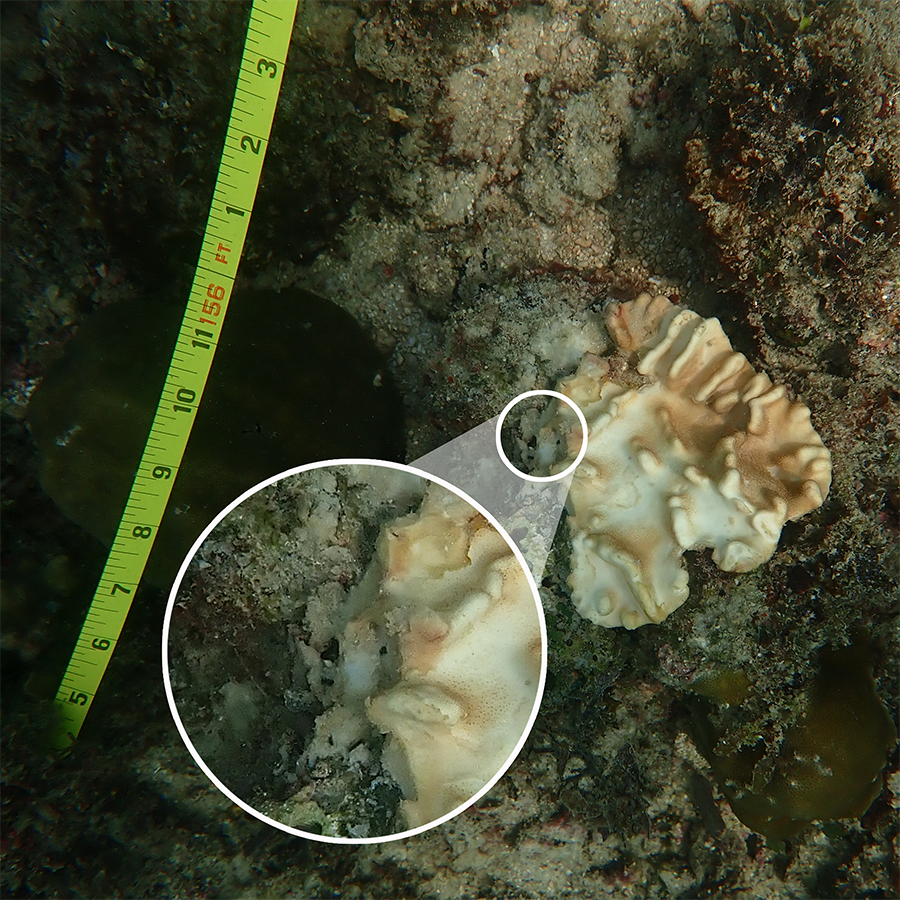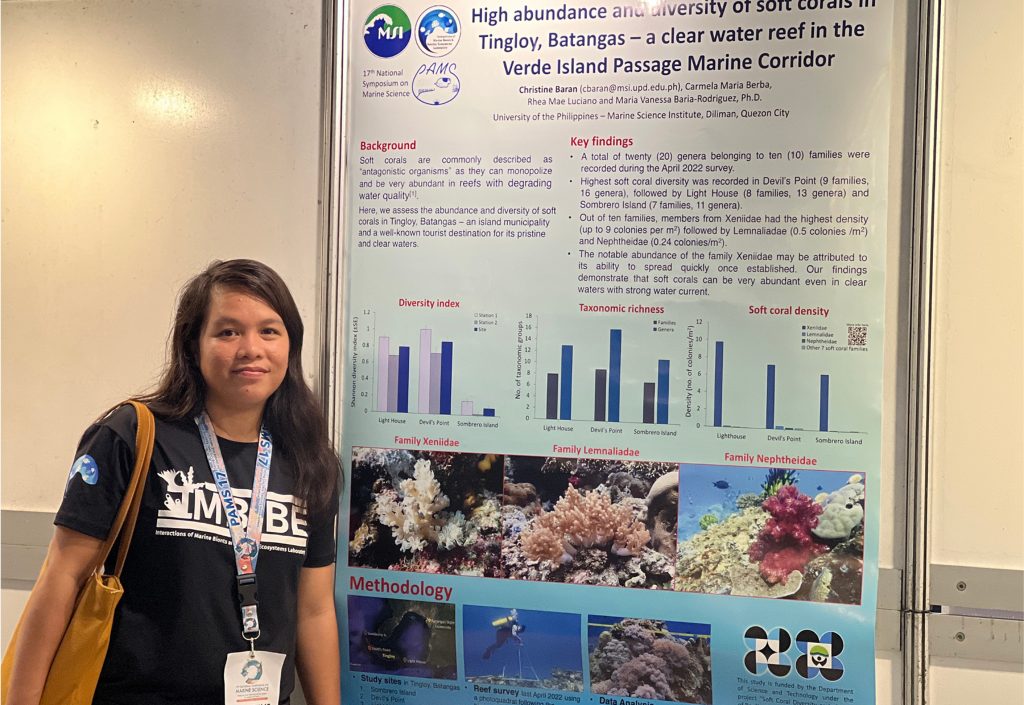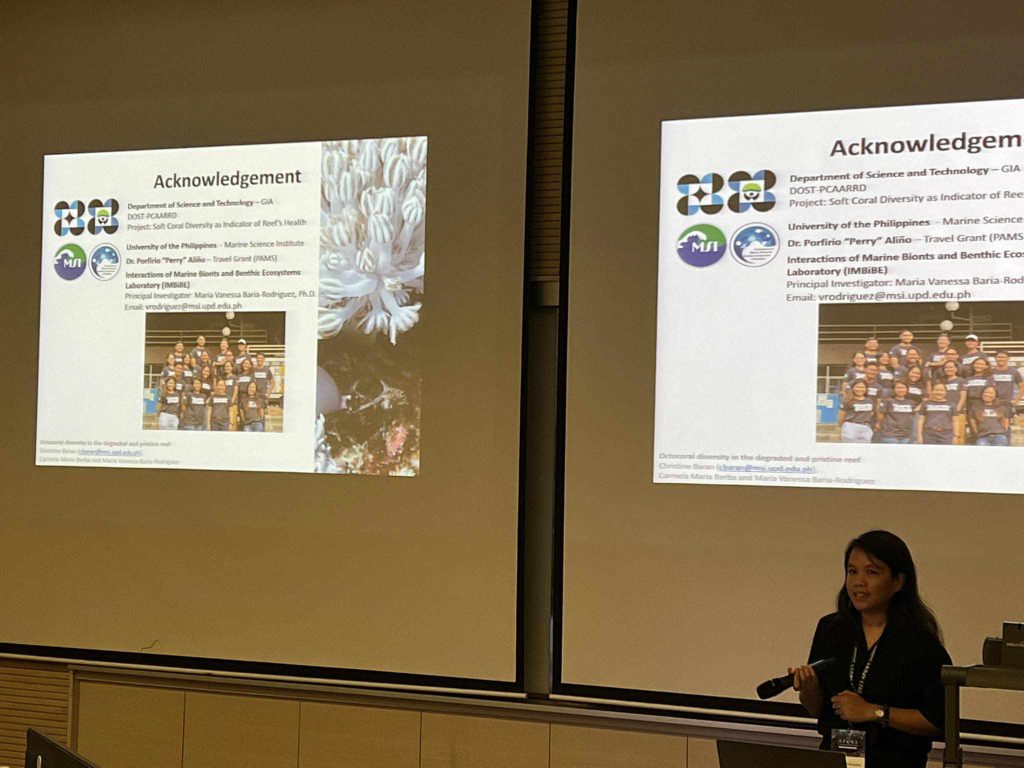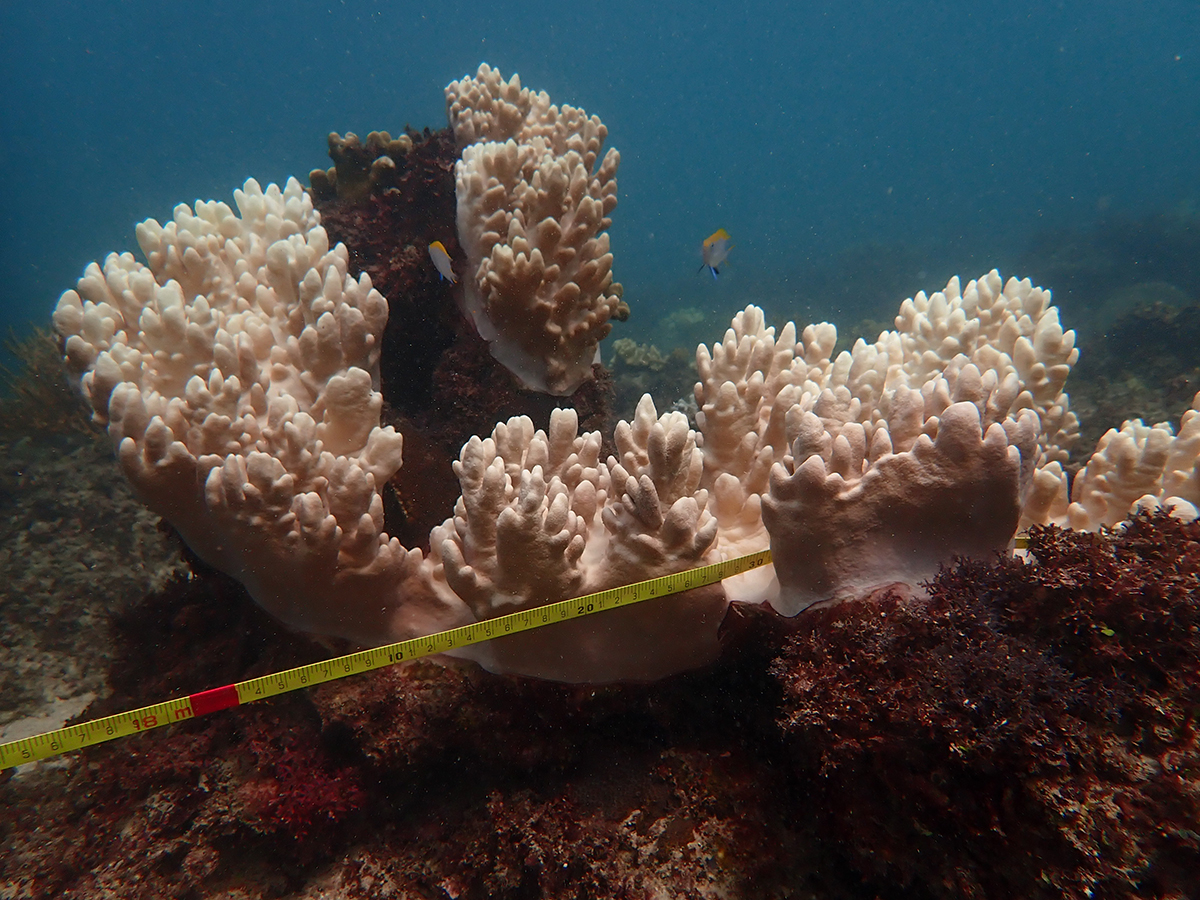A world without color: the bleached soft corals of Bolinao
Featured Photo: Bleached Sclerophytum sp. (previously identified as Sinularia)
Deep in the throes of a global pandemic, the Philippines of 2020 was no stranger to death. Through her research, soft coral scientist Christine Baran found how true this was for our ever-warming reefs as well.
Published in Marine Biology Research last May 2023, “Genus and size-specific susceptibility of soft corals to 2020 bleaching event in the Philippines”[1] was authored by Baran and her fellow colleagues at the UP Marine Science Institute’s Interactions of Marine Bionts and Benthic Ecosystems Laboratory: Rhea Mae Luciano, Christine Segumalian, and Darryl Anthony Valino. Under the supervision of Dr. Maria Vanessa Baria-Rodriguez, the article focuses on how the most common soft coral genera in the Indo-Pacific — Lobophytum, Sarcophyton, and Sclerophytum (formerly Sinularia) — were affected by the bleaching event that swept across the Pacific Ocean four years ago.

Colorless, lifeless
The results were damning. Of the 2050 soft coral colonies in the Bolinao-Anda Reef Complex that were recorded for the study, 51.36% had signs of bleaching. While becoming bleached does not yet mean that the coral is dead, the loss of the zooxanthellae algae that give it color indicates that the coral is already well on the way there.
As if that was not troubling enough, the lack of research on soft corals means that only a small number of people are willing to study them — much less make the effort to save them.
“Their ecological and economic importance is often overlooked,” said Baran. She explained that in the coral reef scientific community, soft corals are ignored. They tend to be aggressively competitive when it comes to hogging space and resources in the reef; like an annoying roommate that keeps taking too much food out of the fridge, soft corals are seen as greedy. This bad reputation is despite the fact that soft corals are significant members of the shallow tropical reefs that surround the country,[2] and are potential sources for new pharmaceutical products as well.[3] Compared to their more charismatic cousin, the hard corals or Scleractinians, soft corals are a hard sell.
Yet there is a certain allure that persists in studying soft corals, especially when few other marine scientists do so. Baran recalled how her research journey was inspired by the Bangsi Festival at nearby Maitum, Sarangani. Dancers would yearly dress up in flowing, colorful outfits to celebrate the flying fish that became the town’s signature delicacy. With the declaration that “everything I do must benefit my hometown”, Baran had thrown herself into marine science in order to fulfill that goal.
Though she is now studying coral reproduction rather than fish, her research shows that Baran is still finding ways to give color back to the sea.

Surprisingly hardy
Luckily, soft corals are tougher than one may think.
Baran et al.’s study is comprehensive enough that it takes four different factors into account: the genus of the coral, the size of the coral colonies, the density of the zooxanthellae found in the coral, and the environment where the coral is found.
There was one particular environment that showed where soft corals were the most safe from bleaching — the study site in RDG, a fringing reef in Bolinao, where the strong waves shielded them from the heat.
Unlike the other study sites, RDG is not a sheltered reef area. It is more exposed to the fierce ocean swells brought by monsoon winds. The swells dissipated the heat to other waters, leading to a cooler environment that protected the corals from more severe bleaching.
The results now are in sharp contrast to 2016, when the corals in RDG were observed to be white and near death.4 Baran and her co-authors believe that some of the larger corals in RDG were survivors that learned to adapt to hotter waters, whose bleached areas reflect thermal stress from 2016 rather than more recent events. It is also notable that many of the unbleached corals were small, young colonies, which could allocate more energy for growth.
Although the monsoon protected the soft corals in RDG, this does not mean that our constant typhoons guarantee safety for our soft corals. While they can mitigate heat stress,[5–6] typhoons may still do more harm than good.
“This still depends on its intensity,” said Rhea Luciano, who is one of the co-authors of the study. “[It can be] positive in that it reduces the ocean temperature by water mixing created by strong winds and currents. In addition, the cloud cover blocks the sunlight, thus preventing warm surface.”
However, she also warned, “Stronger typhoons can cause damage to a thousand-year-old coral reef in a single sweep.”
The strong waves may have been beneficial for the corals, but battling against amihan was definitely a challenge for the researchers. For the study, the three researchers needed to regularly scuba dive underwater for collecting samples and conducting reef surveys. Still, Luciano shared that she found the fieldwork for this study quite fun. Pandemic travel restrictions were an unexpected boon for the three ladies — Baran, Luciano, and Segumalian — who were able to stay at Bolinao for three months for their research. The three of them did all of the fieldwork by themselves.
“Well,” Baran said, when asked about her and her colleagues being #WomenInSTEM, “we are capable of doing this stuff.”

Symbiosis and survival
Coral bleaching is a response to changes in the environment, and is the result of zooxanthellae leaving the coral that shelters them out of stress. For the soft corals in the study, the three genera experienced this loss to varying degrees. The difference in zooxanthellae density between unbleached and severely bleached coral was more extreme in Lobophytum than in Sarcophyton and Sclerophyton (formerly Sinularia).
Without the zooxanthellae, the coral is left without color and without food. The loss of this symbiotic relationship leaves the coral prone to sickness and death.
The connection between coral bleaching and global warming is well-established.[7–8] For the soft corals in the Bolinao-Anda Reef Complex, Baran et al. used data from the US National Oceanic Atmospheric Administration to show that increasing sea temperatures have been causing thermal stress to these corals since 1986. And although coral bleaching is not immediately fatal, successive thermal stress events in both 2019 and 2020 left the corals with little time to recover.[9]
Global warming is not the only threat our corals face. Last year, the UP Marine Science Institute itself had regularly posted news bulletins of the damage that the Mindoro oil spill had brought not only to our marine environment, but the industries and people that depend on it for survival.
“The human population is increasing and there’s no doubt of alarming anthropogenic disturbance,” said Baran. She recalled oil spills as only one of the possible ways man could cause harm to the marine environment. Illegal fishing was also a threat.
This is not a problem science alone can solve. Luciano reminded that protecting the reefs from further harm will take work from several sectors of society. “It requires cooperation from different institutions, agencies, and the communities. The solutions and answers do not happen in a snap of a finger.”
Baran put it simply. “To protect our coral communities, we need to address the issues and threats, especially managing human behavior on how to sustainably use our marine resources.”
Do we still have hope to save our corals? For our researchers, the answer is a resounding yes. We have to. Just as the corals and zooxanthellae depend on each other to live, we depend on the corals too.

This article is posted in commemoration of the International Day of Biological Diversity, an observance of the UN Convention on Biological Diversity. This year’s theme, “Be part of the plan”, is a call to action for governments, indigenous peoples and local communities, non-governmental organizations, lawmakers, businesses, and individuals to work together in protecting life and its ecosystems. The theme refers to the Biodiversity Plan, formally known as the Kunming-Montreal Global Biodiversity Framework, which proposes a global, multi-sectoral framework to halt and reverse biodiversity loss by 2050.
Acknowledgments
The authors are thankful for the support given by the Office of the Vice Chancellor for Research and Development Outright Research Grant (Project no. 202037) and the Marine Science Institute In-house Research Grant of the University of the Philippines. This study was also partially funded by the Soft Coral Diversity as Indicator of Reef’s Health project of the Department of Science and Technology.
References
- Baran, C. C., Luciano, R. M., Segumalian, C. S., Valino, D. A., & Baria-Rodriguez, M. V. (2023). Genus and size-specific susceptibility of soft corals to 2020 bleaching event in the Philippines. Marine Biology Research, 19(2-3), 165-176. DOI: 10.1080/17451000.2023.2198242. ↩︎
- Shoham, E., & Benayahu, Y. (2016). Higher species richness of octocorals in the upper mesophotic zone in Eilat (Gulf of Aqaba) compared to shallower reef zones. Coral Reefs, 36(1), 71–81. DOI: 10.1007/s00338-016-1528-7. ↩︎
- Edrada, R. A., Proksch, P., Wray, V., Witte, L., & van Ofwegen, L. (1998). Four New Bioactive Lobane Diterpenes of the Soft Coral Lobophytum pauciflorum from Mindoro, Philippines. Journal of Natural Products, 61(3), 358–361. DOI: 10.1021/np970276t. ↩︎
- Quimpo, T. J. R., Requilme, J. N. C., Gomez, E. J., Sayco, S. L. G., Tolentino, M. P. S., & Cabaitan, P. C. (2016). Low coral bleaching prevalence at the Bolinao-Anda Reef Complex, northwestern Philippines during the 2016 thermal stress event. Marine Pollution Bulletin, 160, 111567. DOI: 10.1016/j.marpolbul.2020.111567. ↩︎
- Nadaoka, K., Nihei, Y., Kumano, R., Yokobori, T., Omija, T., & Wakaki, K. (2001). A field observation on hydrodynamic and thermal environments of a fringing reef at Ishigaki Island under typhoon and normal atmospheric conditions. Coral Reefs, 20(4), 387–398. DOI: 10.1007/s00338-001-0188-3. ↩︎
- Chou, L. M., Toh, T. C., Toh, K. B., Ng, C. S. L., Cabaitan, P., Tun, K., Goh, E., Afiq-Rosli, L., Taira, D., Du, R. C. P., Loke, H. X., Khalis, A., Li, J., & Song, T. (2016). Differential Response of Coral Assemblages to Thermal Stress Underscores the Complexity in Predicting Bleaching Susceptibility. PLoS ONE, 11(7), e0159755. DOI: 10.1371/journal.pone.0159755. ↩︎
- Hoegh-Guldberg, O., Mumby, P. J., Hooten, A. J., Steneck, R. S., Greenfield, P., Gomez, E., Harvell, C. D., Sale, P. F., Edwards, A. J., Caldeira, K., Knowlton, N., Eakin, C. M., Iglesias-Prieto, R., Muthiga, N., Bradbury, R. H., Dubi, A., & Hatziolos, M. E. (2007). Coral Reefs Under Rapid Climate Change and Ocean Acidification. Science, 318(5857), 1737–1742. DOI: 10.1126/science.1152509. ↩︎
- Hughes, T. P., Anderson, K. D., Connolly, S. R., Heron, S. F., Kerry, J. T., Lough, J. M., Baird, A. H., Baum, J. K., Berumen, M. L., Bridge, T. C., Claar, D. C., Eakin, C. M., Gilmour, J. P., Graham, N. A. J., Harrison, H., Hobbs, J.-P. A., Hoey, A. S., Hoogenboom, M., Lowe, R. J., & McCulloch, M. T. (2018). Spatial and temporal patterns of mass bleaching of corals in the Anthropocene. Science, 359(6371), 80–83. DOI: 10.1126/science.aan8048. ↩︎
- Slattery, M., Pankey, M. S., & Lesser, M. P. (2019). Annual Thermal Stress Increases a Soft Coral’s Susceptibility to Bleaching. Scientific Reports, 9(8064). DOI: 10.1038/s41598-019-44566-9. ↩︎

